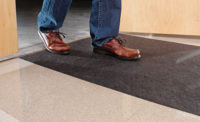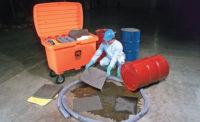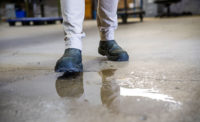Telling employees to watch their step isn’t enough to eliminate slip, trip and fall injuries in production areas. Like other safety hazards, slip, trip and fall hazards can be identified and in many cases eliminated.
Recognizing hazards, following good housekeeping procedures, establishing a footwear program and conducting regular inspections are elements of a floor safety program that can reduce or eliminate injuries. Many floor safety improvements can be implemented for less than the cost of a single injury.
Designate walkways
Machinery, work tables and other items in production areas are commonly bolted to the floor to provide stability or to keep them from moving. It also gives them a sense of permanency. Aisles and walkways should have the same sense of belonging.
Permanently designating and marking aisles and walkways gives employees dedicated pathways to follow to, from and in work areas. Each aisle and walkway can be clearly defined with paint, tape or even physical barricades.
Shield overspray
Oils, coolants and water are three types of liquids used to cool the surfaces of tools and parts. When they overshoot their target, the resulting overspray can end up on the floors in aisles, walkways and work areas, creating a slip and fall hazard. Often, these liquids are essential to operations and can’t be eliminated.
Confining overspray with curtains, walls or other forms of shielding can sometimes help to keep the overspray from leaving a designated area. Raised flooring, grates and absorbent matting on floors can help to improve traction. Mopping or using squeegees can also improve the condition of walking surfaces where overspray can’t be channeled or eliminated.
Choose correct footwear
Sometimes, due to the nature of the work it is not possible to keep floors clean and dry all the time. While efforts should still be made to keep floors as safe as possible by other means, incorporating a safety footwear program can enhance floor safety efforts.
When choosing slip-resistant footwear, work with suppliers to match the most appropriate tread patterns and sole compositions to the work environment. The terms “slip-resistant” or “slip-proof” need to be qualified to ensure that they match the intended uses of the footwear.
The tread patterns and polymers of footwear used to resist the effects of chemicals and engine oils are different than those used in foodservice. They are also different from shoes designed to minimize slips in areas that are coated with dry dusts and those for outdoor workers climbing elevations in loose soil.
General housekeeping
Some facilities use changeovers and scheduled shutdowns as an opportunity to conduct all their good housekeeping efforts. While there are some housekeeping tasks that may need to wait, daily housekeeping can help to minimize the amount of time that needs to be spent during shutdowns and can prevent floor conditions from becoming hazardous between downtimes. It can even extend the useful life of many floor surfaces.
Maintaining a clean, safe workplace also improves work morale and can enhance production rates. Proper sanitation, including keeping work areas clean, orderly and dry is also something that OSHA inspectors look for and use as a gauge of overall compliance.
Dedicating just a few minutes…
Dedicating a few minutes at the end of each shift to clean up work areas, sweep and mop floors, remove debris and put tools back in order minimizes the chance of slip, trip and fall injuries. Providing employees with the time to clean up their workspaces and easy access to the right tools, equipment and cleaning products facilitates good housekeeping policies.
When work areas are maintained daily, changeovers and scheduled downtime can be better used to refinish floors or make other types of larger, overall floor and surface repairs.
Inspection frequency varies
OSHA requires walking surfaces to be inspected “regularly, and as necessary” to ensure that they are clean and safe [29 CFR 1910.22(d)(1)]. For some facilities, this may mean hourly. For others, once a week or every other week may be often enough. Inspection frequencies may even vary by area. It is up to the facility to determine what schedule makes the most sense for them to prevent slip and fall injuries.
One way to help quantify the safety of a walking surface during inspections is to measure its coefficient of friction using a tribometer or slip meter. The higher the coefficient friction, the less likely it is for the surface to contribute to an incident. Measurements can also be used to determine if it’s time for a walking surface to be refinished to maintain its slip resistance.
Inspections help to identify conditions that may contribute to an incident such as leaks that enter walkways, holes, uneven surfaces or loose floorboards. When an inspection identifies an unsafe condition, it must be corrected or repaired immediately. If it cannot be repaired, it must be guarded until corrections can be made [29 CFR 1910.22(d)(2)].
Recognizing floor safety hazards and preventing the conditions that cause slips, trips and falls minimizes the potential for injuries. Teaching employees to keep up with good housekeeping efforts and following floor safety procedures will help keep everyone on their feet.



